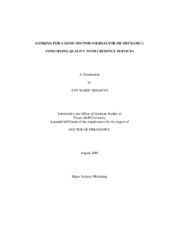| dc.description.abstract | Little is known about how people evaluate credence attributes, that is, those attributes which the consumer often cannot fully evaluate even after purchasing and consuming the product. And yet consumers struggle to evaluate quality in several important product categories dominated by credence attributes such as food safety, medical services, legal services, and pharmaceuticals, among others. The dissertation explores the processes by which people form quality evaluations of services high in credence attributes and the consequences of those evaluations. Drawing on the service quality, dual-process social information processing, expert-novice and risk literatures, I develop a conceptual model to illustrate how skill and motivation moderate the ways people seek and integrate observable information to infer unobservable quality. The influence of quality evaluations on outcome, satisfaction, value, and loyalty is mapped. The model is tested in the context of a classic credence service, health care services with two large datasets using structural equation modeling.
Study 1 draws on an existing patient satisfaction database (6,280 records) to measure the sources and consequences of quality evaluations. Study 2 validates Study 1 findings and extends those findings to show the moderating roles of product expertise and perceived risk on quality evaluation processes. The second study is tested with 1,379 consumers (patients) drawn from an online consumer panel.
The research suggests service quality in this context refers narrowly to the attributes of the core product (here, the physician‘s medical competence); interpersonal and organizational quality are associated with value, satisfaction and loyalty, rather than overall quality. Two paths to quality evaluations appear to exist. In the first, consumers integrate evidence of the physician‘s capabilities, practices, and prior outcomes to reach evaluations of technical quality. In the second path, consumers rely on a trust heuristic in which observed interpersonal and organizational quality signals are used to build trust in the physician; that trust, in turn, influences perceptions of technical quality. The trust heuristic appears to be used when the stakes are low and, counterintuitively, when the stakes are high, just when superior evaluations are most needed. | en |


